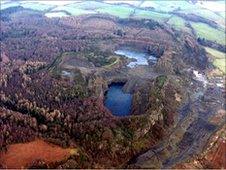Legal threat over Gillies Hill quarry
- Published

Protesters fear the hill would be destroyed by more quarrying
Stirling Council has agreed to back legal action which could prevent quarrying at a historic battle site.
Permission to quarry at Gillies Hill, the site of the Battle of Bannockburn, was granted in 1982, but there has been little activity for 14 years.
However, protesters are worried that the reactivation of large-scale quarrying would destroy the hill.
A voluntary agreement with the quarriers will be sought before legal action is taken.
Stirling Council said it shared "significant concerns" with the people of Cambusbarron about the possible resumption of quarrying.
Councillors pledged on Thursday evening to help secure a written commitment from the quarry operators that they will not restart work before 2017, when the conditions are next reviewed.
If this fails, the council said it would fund any legal action taken by Cambusbarron Community Council.
Robert the Bruce
A court order could force Tarmac and Hanson - the two companies with permission to operate Murrayshall Quarry - to agree to an Environmental Impact Assessment.
The assessment should have been carried out in 2002 when permission was last reviewed.
Both companies have said they have no plans to restart quarrying at Gillies Hill before 2017, but technically could begin work at any time.
Gillies Hill is reputedly where Robert the Bruce's followers took shelter during the 1314 Battle of Bannockburn before their charge on the enemy.
When they emerged from the woods south of Stirling on 24 June 1314, the English army took fright, mistaking them for Scottish reinforcements.
On Sunday, a march organised by the Save Gillies Hill group re-enacted the "descent of the gillies" after a piper-led procession.
The area is also home to red squirrels, peregrine falcons and a Scots Pine which the Forestry Commission has designated as one of Scotland's top 100 heritage trees.
- Published20 June 2010